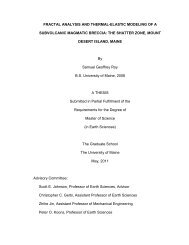Jumars, P.A. - University of Maine
Jumars, P.A. - University of Maine
Jumars, P.A. - University of Maine
Create successful ePaper yourself
Turn your PDF publications into a flip-book with our unique Google optimized e-Paper software.
1 2 6<br />
P. A . JUMARS<br />
E<br />
F<br />
Figure 12 . Ophryotrocha hadalis sp . nov : A, parapodium 10 ; B, anterior in dorsal view, left palp<br />
and antenna missing ; C, simple seta <strong>of</strong> parapodium 10 ; D, compound seta <strong>of</strong> parapodium 10 ;<br />
E, compound seta <strong>of</strong> parapodium 20 ; F, entire maxillae in dorsal view with denticle rows spread<br />
apart ; G, mandibles in dorsal view . A-E are from the holotype ; F and G are from the paratypes .<br />
present on the prostomium (Fig . 12B) below the level <strong>of</strong> the antennae . The<br />
palps are inserted laterally just anterior to the first peristomial ring . Eyes are<br />
absent . Parapodia (Fig . 12A) lack dorsal cirri ; ventral cirri are short and digitate<br />
from the first parapodium . Setae become progressively thinner, longer, and<br />
smoother in proceeding from anterior to posterior setigers . Capillaries are<br />
always present dorsally on the neuropodium . Those in the anterior few setigers<br />
are denticulate as are the distal ends <strong>of</strong> the shafts <strong>of</strong> the compound falcigers<br />
(Fig . 12C,D) . The decrease in thickness <strong>of</strong> more posterior setae is associated<br />
with the loss <strong>of</strong> all denticulation and a gradual change from short-appendaged<br />
falcigers to long-appendaged spinigers (Fig . 12E) . The pygidium is unknown .<br />
Carriers and basal plates all appear fused (Fig . 12F) . In each <strong>of</strong> the two<br />
denticle series, four denticles are plate like and two are falcate . The former<br />
clearly belong to the inferior row and the latter clearly belong to the superior<br />
row . One additional denticle in each series appears to be the result <strong>of</strong> fusion <strong>of</strong>
















